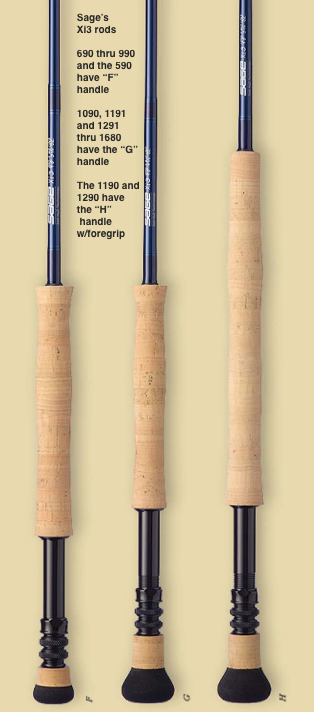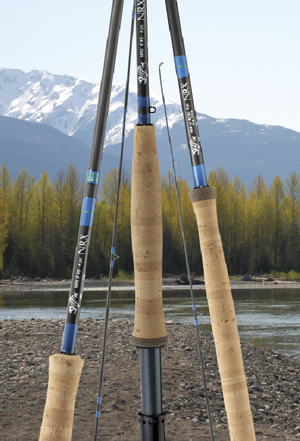So, what are we getting in an $800 rod that we would not get in a $200 rod. Distance? Accuracy? Aesthetics? Lightness? Strength? Craftsmanship? Warranty?
Well, there are rods priced from $200 to $800 that offer all of those things with varying degrees of success that are not directly hinged upon said price. I cannot look you in the eye and say that inexpensive rods made carefully overseas are going to serve you less well in technical and demanding fishing situations that you may find in both saltwater and freshwater. Some will and some will not. Neither will I say to you that rods manufactured in the United Sates are all going to perform at the top level. There are superb rods offered from both domestic and foreign manufacturers. And there are rods that cast like shit from both sides of the pond.
Certain things are true
Historically, US rods are made to higher standards which translates to better quality: fewer imperfections and defects than rods made overseas.
Large US made rod companies that spend a lot of money to market, advertise and promote their line must build those expenses into their business plan, which in turn makes the rods more expensive for the consumer.
Companies in both the Untied States and Asia offer rods that are suitable for a range of casting levels from beginner to professional, sweet water to salt, precision casting to bombing sticks.
Most manufacturers offer lifetime warranties (no questions asked) for their fly rods.
Rods are a bit like boats; where they excel in one area, they are likely to fall short in another. Everything is a compromise. It is all about the balance required for your particular application. Just as a boat with a nice deep vee will cut through the heavy chop on a rough day, it will also rock from side to side when not under way and, of course, draw more water. Conversely, the flatter bottomed boat will loosen some of your fillings running in a chop, but will float in mere inches of water and not rock as you drift and fish. A flats fisherman will take his lumps going from flat to flat so that he can be stealthy and shallow when he gets to the flat. An angler targeting false albacore tuna would choose the deeper vee’d boat necessary to chase and hunt the little torpedoes in rougher waters and higher winds. Similarly, the flats fisherman is wiser to choose a rod with a delicate tip, designed for presentation rather than the aforementioned bombing stick that false albacore fisherman may require for long casts and high winds. So where you gain in delicacy and presentation, you will lose in power. Of course, finding that perfect blend of functions for each individual’s needs and skill set is what we are driving at.
Warranties
Most rods these days come with a lifetime warranty. That is for the lifetime of the rod. But, what if the company goes away? Well, I guess then the warranty goes with it. That is some food for thought that you may want to keep in mind when making the next choice for your quiver. Also, some companies replace broken rods and some companies repair broken rods. While these repairs are generally of excellent quality (they will build you an entirely new rod section), they can be time consuming. Meaning, if you break the rod in September, you may not get it back until the end of November. Companies that replace broken rods have a much faster turnaround (some as little as 2 days). Most companies charge a menial fee for repair or replacement, which helps them cover the cost of shipping and handling.
I remember very well the lack of quality in the overseas rods when they began to come to market in the late 90s. Breakage, sloppy craftsmanship and inefficient tapers were the norm. That is no longer the case. Many overseas manufacturers have very stringent quality control and product development ensuring long lasting rods that perform at the highest level. These companies save a lot in labor and manufacturing, and presumably pass that savings along to the buyer. The addition of a lifetime warranty takes the fear out this leap of faith.
Now, if they started giving out fly rods for free tomorrow, it is unlikely that I would go first to the bins from China and Korea and pick them for my arsenal before hitting up the bins from Colorado, Washington, and Montana. But, in the end, my shopping spree would definitely be one of a worldly and international design. Since rods aren’t free, my current arsenal includes rods from all over the globe. I fish them all with frequency and success.
If you are an experienced caster looking for a precision casting rod for educated tailing bonefish, you would be well advised to cast all of the seven or eight weights rods with a softer tip (for delicate presentation) that fall within your price range, whatever that may be. No matter your price range, you have options and enough money to procure a rod that will perform well and still be under warranty against breakage.
 The highest profile, less expensive fly rods are those touted by Lefty Kreh – Temple Fork. Many folks I know, including professional guides say that the TFO’s TiCrx Signature Series, 9-weight, 4 piece 9-footer is as good as any $600 rod out there. I have owned a couple of them and love them for many applications, (can you say “bomber rod”?). President of TFO, Rick Pope, summarizes the company’s mantra; “Our goal is to increase participation in and awareness of fly fishing by offering the best possible combination of price and performance in rods.”
The highest profile, less expensive fly rods are those touted by Lefty Kreh – Temple Fork. Many folks I know, including professional guides say that the TFO’s TiCrx Signature Series, 9-weight, 4 piece 9-footer is as good as any $600 rod out there. I have owned a couple of them and love them for many applications, (can you say “bomber rod”?). President of TFO, Rick Pope, summarizes the company’s mantra; “Our goal is to increase participation in and awareness of fly fishing by offering the best possible combination of price and performance in rods.”
A relative newcomer to the Game, Rise Rods out of Long Island, NY, is a company that prides itself in creating a high performance product made to stringent quality standards overseas. Co-owner and designer, Captain Amanda Switzer speaks to the merit’s of their particular method of production in the current world climate:
“Our method of production allows us to offer a top quality fly rod at a very reasonable and affordable price while contributing 20% of our profits to environmental and conservation minded charities.”
One such charity is Trout Unlimited’s Headwaters Youth Education Initiative. This sort of contribution would simply not be possible with a domestic made rod and celebrity endorsements with flashy ad campaigns. Co-owner and designer Steve Bechard explains, “Rigorous testing by pros as well as Joes for over a year, coupled with instant feedback on a global scale allowed us to tweak tapers, components, finishes, and nuances to get the rods where they needed to be.” Rise sells all rods with two identical tip sections and backs their product with a lifetime warranty policy requiring $25 for a new tip or $50 for the replacement of a broken rod.
Other Side of the Pond
One of the newest and most impressive rods in the domestic contingency of fly rods is the Sage TCX ($815 for 9-foot, 4 piece., 9-weight), brainchild of rod designer Jerry Siem. Something of a “bomber rod” built for long casts and a powerful stroke, this rod replaces its ever popular predecessor, the TCR using what Sage terms G5 technology. Siem speaks to its advantages in design, “With the new TCX, we’ve got a rod that is lighter, narrower in profile, responds quicker, dampens faster, and allows higher line speed than its predecessor.” If the proof is in the pudding, then that bodes well for this bright green casting machine. In my experience, it seemed to have a more delicate tip than the TCR without really sacrificing much of the power. With the TCX, Siem has designed another great casting rod and Sage is producing them with beauty and consistency out of their Bainbridge, WA facility. Sage also takes advantage lower production costs by manufacturing many items overseas. Most of their reels, their components and their offerings from Redington Tackle are made overseas. Many of these products offer quality at an affordable price.
And finally we move onto the inventors of one of the most convenient warranty options in the game. G. Loomis’ expeditor program requires you to call 1-800 G LOOMIS, give them a CC# for a $100 charge. They send you a replacement for your broken stick. When it arrives two days later, you replace the new rod in the box with broken rod and apply their post paid mailing label. Done and back to fishing. This one time expeditor option is in addition to a regular warranty repair option. Now, onto said rods. Utilizing their most cutting edge technologies, Loomis created the NRX line of rods ($770 for 9-foot, 4 piece., 9-weight). Casting and rod design guru, Steve Rajeff created their latest using “Nano Resin technology to boost the strength of the fiber and resin relationship”. He adds, “What an angler will feel is lightness, strength and control.” Like Sage, G Loomis makes their rods in Washington State and many of their reels and accessories overseas.
The Skinny
Fly rods are like golf clubs, tennis racquets, skis and a lot of other things. What was advertised as a breakthrough technology five years ago is probably commonplace now or perhaps completely gone with the times. New technology requires expensive development and testing and is only new for a certain period of time but that certainly has value. So if you want the newest, lightest, and most cutting edge domestic rods for today, it comes at a monetary price, currently somewhere in the $800 range. If you are comfortable with something that falls somewhere on the less pioneering side of that, then there are multitudes of choices. The really great thing we have to our advantage when choosing a new stick for the quiver is that great number of options for every wallet. Cast as many as you can and then choose one with an action, appearance, and a warranty that works for you.



